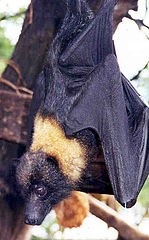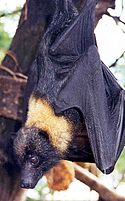Rudawka mariańska
| Pteropus mariannus[1] | |||
| Desmarest, 1822 | |||
 | |||
| Systematyka | |||
| Domena | |||
|---|---|---|---|
| Królestwo | |||
| Typ | |||
| Podtyp | |||
| Gromada | |||
| Podgromada | |||
| Infragromada | |||
| Rząd | |||
| Podrząd | |||
| Rodzina | |||
| Rodzaj | |||
| Gatunek | rudawka mariańska | ||
| Synonimy | |||
| |||
| Podgatunki | |||
| Kategoria zagrożenia (CKGZ)[11] | |||
 | |||
| Zasięg występowania | |||
(c) IUCN Red List of Threatened Species, species assessors and the authors of the spatial data., CC BY-SA 3.0 | |||
Rudawka mariańska[12], rudawka okinawska[12] (Pteropus mariannus) – gatunek ssaka z podrodziny Pteropodinae w obrębie rodziny rudawkowatych (Pteropodidae).
Taksonomia
Gatunek po raz pierwszy zgodnie z zasadami nazewnictwa binominalnego opisał w 1822 roku francuski zoolog Anselme Gaëtan Desmarest nadając mu nazwę Pteropus mariannus[13]. Holotyp pochodził z Guam, na Marianach, w Stanach Zjednoczonych[14].
Pteropus mariannus należy do grupy gatunkowej griseus[15]. Taksony pelewensis, ualanus i yapensis są często wymieniane jako podgatunki P. mariannus, ale badania potwierdziły ich odrębny status gatunkowy[15]. Status taksonomiczny P. loochoensis z Okinawy (Riukiu, Japonia) pozostaje niepewny; jest znany z zaledwie dwóch okazów odłowionych w XIX wieku i uważany jest za konspecyficzny lub wymarły podgatunek P. mariannus[15]. Autorzy Illustrated Checklist of the Mammals of the World rozpoznają trzy podgatunki[15]. Podstawowe dane taksonomiczne podgatunków (oprócz nominatywnego) przedstawia poniższa tabelka:
| Podgatunek | Oryginalna nazwa | Autor i rok opisu | Miejsce typowe |
|---|---|---|---|
| P. m. paganensis | Pteropus marianus paganensis | Yamashina, 1932 | Pagan, Mariany, Stany Zjednoczone[16]. |
| P. m. ulthiensis | Pteropus marianus ulthiensis | Yamashina, 1932 | Ulithi, zachodnie Karoliny, Mikronezja[17]. |
Etymologia
- Pteropus: gr. πτερόπους pteropous „skrzydłostopy”, od πτερον pteron „skrzydło”; πους pous, ποδος podos „stopa”[18].
- mariannus: Mariany, Ocean Spokojny[19].
- paganensis: Pagan, Mariany[10].
- ulthiensis: Ulithi , Mikronezja[10].
Zasięg występowania
Rudawka mariańska występuje w zależności od podgatunku[15]:
- P. mariannus mariannus – południowe Mariany (Saipan, Tinian, Aguijan, Rota i Guam).
- P. mariannus paganensis – północne Mariany (Farallon de Pajaros, Maug, Asuncion, Agrihan, Pagan, Alamagan, Zealandia Bank i Anatahan).
- P. mariannus ulthiensis – Ulithi (stan Yap, Mikronezja).
Morfologia
Długość ciała 195–250 mm, ogona brak, długość ucha 25–26 mm, długość tylnej stopy 52–54 mm, długość przedramienia 134–154 mm; masa ciała 270–577 g; samce są nieco większe od samic[20].
Znaczenie gospodarcze
Mięso tych rudawek (w języku czamorro określanych fanihi) stanowi element miejscowej kuchni, co wiązane jest z rzadką neurologiczną chorobą występującą w drugiej połowie XX wieku na Guam, lytico-bodig.
Status zagrożenia
Liczebność kolonii tego zwierzęcia znacznie się zmniejszyła w ostatnich latach.
Uwagi
Przypisy
- ↑ Pteropus mariannus, [w:] Integrated Taxonomic Information System [online] (ang.).
- ↑ J.R.C. Quoy & J.P. Gaimard: Description des Mammifères. W: L.C.D. de Freycinet (red.): Voyage autour du monde, entrepris par ordre du roi. Exécuté sur les corvettes de S.M. l’Uranie et la Physicienne, pendant les années 1817, 1818, 1819 et 1820. T. 3: Zoologie. Paris: Chez Pillet aîné, 1824, s. 51. (fr.).
- ↑ C.J. Temminck: Monographie de mammalogie. T. 1. Paris: 1824, s. 186. (fr.).
- ↑ J.R.C. Quoy & J.P. Gaimard: Genre Roussette. — Pteropus, Brisson. W: J.-S.-C. Dumont d’Urville (red.): Voyage de la corvette l’Astrolabe: exécuté par ordre du roi, pendant les années 1826-1827-1828-1829. T. 1: Zoologie. Paris: J. Tastu, 1830, s. 77. (fr.).
- ↑ J. E. Gray. A Revision of the Genera of Bats (Vespertilionidae), and the Description of some new Genera and Species. „Magazine of Zoology and Botany”. 2 (12), s. 503, 1838. (ang.).
- ↑ L. Oken: Allgemeine Naturgeschichte für alle Stände. Cz. 7. Stuttgart: Hoffman, 1838, s. 990. (niem.).
- ↑ J.E. Gray: Catalogue of Monkeys, Lemurs, and Fruit-eating Bats in the collection of the British Museum. London: The Trustees, 1870, s. 106. (ang.).
- ↑ A. Seitz. Vergleichende Studien über die Fauna von China und Japan. „Mitteilungen der Deutschen Gesellschaft für Natur- und Völkerkunde Ostasiens”. 5, s. 364, 1892. (ang.).
- ↑ a b A. Fritze. Die Fauna der Liu-Kiu-Insel Okinawa. „Zoologische Jahrbücher Abteilung für Systematik, Geographie und Biologie der Tiere”. 7, s. 854, 1894. (niem.).
- ↑ a b c d Y. Yamashina. New subspecies of bats from the mandated South Pacific islands. „Transactions of the Natural History Society of Formosa”. 22, s. 240–241, 1932. (ang.).
- ↑ T. Mildenstein, Pteropus mariannus, [w:] The IUCN Red List of Threatened Species 2020 [online], wersja 2021-3 [dostęp 2022-06-11] (ang.).
- ↑ a b Nazwy zwyczajowe za: W. Cichocki, A. Ważna, J. Cichocki, E. Rajska-Jurgiel, A. Jasiński & W. Bogdanowicz: Polskie nazewnictwo ssaków świata. Warszawa: Muzeum i Instytut Zoologii PAN, 2015, s. 85. ISBN 978-83-88147-15-9. (pol. • ang.).
- ↑ A.G. Desmarest: Mammalogie, ou, Description des espèces de mammifères. Cz. 2. Paris: Chez Mme. Veuve Agasse, imprimeur-libraire, 1822, s. 547, seria: Encyclopédie méthodique. (fr.).
- ↑ D.E. Wilson & D.M. Reeder (redaktorzy): Species Pteropus mariannus. [w:] Mammal Species of the World. A Taxonomic and Geographic Reference (Wyd. 3) [on-line]. Johns Hopkins University Press, 2005. [dostęp 2022-06-11].
- ↑ a b c d e C.J. Burgin, D.E. Wilson, R.A. Mittermeier, A.B. Rylands, T.E. Lacher & W. Sechrest: Illustrated Checklist of the Mammals of the World. Cz. 2: Eulipotyphla to Carnivora. Barcelona: Lynx Edicions, 2020, s. 110. ISBN 978-84-16728-35-0. (ang.).
- ↑ Zijlstra ↓, s. N#19848.
- ↑ Zijlstra ↓, s. N#19849.
- ↑ T.S. Palmer. Index Generum Mammalium: a List of the Genera and Families of Mammals. „North American Fauna”. 23, s. 596, 1904. (ang.).
- ↑ The Key to Scientific Names ↓, mariannae [dostęp 2022-06-11].
- ↑ N. Giannini, C. Burgin, V. Van Cakenberghe, S. Tsang, S. Hintsche, T. Lavery, F. Bonaccorso, F. Almeida & B. O’Toole: Family Pteropodidae (Old World Fruit Bats). W: D.E. Wilson & R.A. Mittermeier (redaktorzy): Handbook of the Mammals of the World. Cz. 9: Bats. Barcelona: Lynx Edicions, 2019, s. 145–146. ISBN 978-84-16728-19-0. (ang.).
Bibliografia
- The Key to Scientific Names, J.A. Jobling (red.), [w:] Birds of the World [online], S.M. Billerman et al. (red.), Cornell Lab of Ornithology, Ithaca (ang.).
- J.S. Zijlstra: Home. Hesperomys project. [dostęp 2022-06-11]. (ang.).
Media użyte na tej stronie
Autor: (of code) -xfi-, Licencja: CC BY-SA 3.0
The Wikispecies logo created by Zephram Stark based on a concept design by Jeremykemp.
(c) IUCN Red List of Threatened Species, species assessors and the authors of the spatial data., CC BY-SA 3.0
Mariana Fruit Bat (Pteropus mariannus) range
WOE 92 Mariana Fruit Bat, Pteropus mariannus mariannus
English Wikipedia, original upload 18 August 2005 by ZeWrestler and edited and reuploaded by Fir0002 (there's one brighter version at en:Image:Mariana Fruit Bat.jpg)




